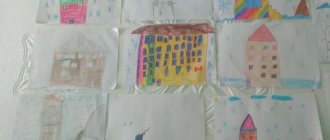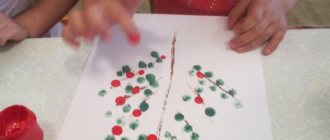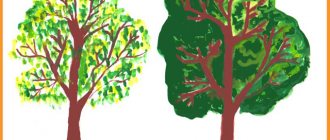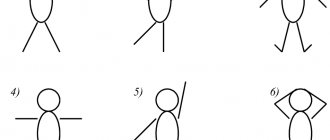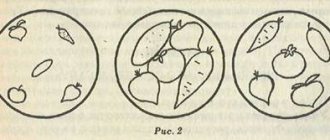Distribution of activities between project participants
Teachers:
- The teacher has knowledge about the past and present of his city, its attractions, and traditions.
- Active interaction with the families of students.
- Organize work to implement the project.
Children:
- Children, together with adults, collect information from various sources.
- Express (sketch) their ideas.
- Participate together with parents and teachers in the presentation and defense of the project.
Parents:
- Together with the child, they collect information from different sources.
- Together with the child, they draw up a project, make sketches, etc.
- Parents have knowledge about the past and present of their city, its attractions, and traditions.
Integration of educational areas:
- “Communication”, “Cognition”, “Artistic creativity” (drawing, applique),
- “Reading fiction”, “Music”, “Health”, “Safety”, “Work”.
Expected outcome of the project
- Know the names of surrounding streets.
- Recognize historical places and city names from pictures.
- Know the people who glorified the city.
- Compose a coherent story based on pictures and slides about your hometown.
- Be able to find and select material together with parents on a given topic.
- Respect the historical past of your city and take care of its attractions.
Main stages of the project:
Stage 1 – preparatory.
Includes: studying the knowledge of parents and children in this area, replenishing the teacher’s knowledge about the history of the city, its cultural attractions, traditions, planning work, choosing forms and methods, selecting illustrative and literary material for working with children.
Stage 2 – practical, research.
It includes two areas: interaction with children, cooperation with parents of students.
Stage 3 – generalization.
Project presentation.
| № | Forms of work on the project | Participants | Replenishment of the development environment. | ||||
Stage I Preparatory | |||||||
| Situational conversation: “Where do street names come from?” | Teachers, children | Illustrations depicting city streets | |||||
| Selection of fiction, books to read and tell to children. | Teachers, parents | Replenishing the book corner. | |||||
| Questioning parents: “Do you know your city?” | Teachers, children | Preparation of forms for the questionnaire. | |||||
Stage II Research | |||||||
| Game - journey “We are walking around the city” | Teachers, children, parents | ||||||
| Looking at illustrations of the city. Looking at a map of the city. | Teachers, children, parents | Photos of the city. | |||||
| Excursion: “Getting to know the city” Compiling an essay after the excursion: “What I saw...” | Teachers, children, parents | Make cards and fill up the speech corner. | |||||
| Situational conversation: “The history of the city.” | Teachers, children. | View photos. | |||||
| Examination of photographs and conversation-reasoning: “The old and new city of Novokuibyshevsk.” | Teachers, children. | Pictures and photos of the city | |||||
| Writing creative stories: “Why I love my city.” | Teachers, children, parents. | Replenishing the book corner. | |||||
| Productive activities of children: Drawing: “My hometown.” Construction: “Buildings in the city.” Application: “Evening city”. | Teachers, children. | Exhibition of children's works. | |||||
| Situational conversation: “How and by whom was the city created and built?” | Teachers, children. | Photos. | |||||
| Auction: “My City” (guessing riddles, reading poems about the city). | Teachers, children. | Replenishment of the speech and book corner | |||||
| Role-playing games: “Trip around the city”, “Shop”, “Hairdresser”. | Teachers, children. | Prepare attributes for the game. | |||||
| Reading fiction about the city (poems, stories, proverbs, riddles) | Teachers, children. | Replenish the book corner art.lit-oh. | |||||
| Making a homemade book: “The city where I live.” | Teachers, children, parents. | Enrich the speech and book corner | |||||
| Viewing slides and videos about the city. Creating a computer presentation: “My city is Novokuybyshevsk.” | Teachers, children. | Presentation file. | |||||
| D/y: “Why is the city always beautiful?”, “How does the city grow?”, “The city is like a trading city”, D/y: “The most attentive citizen”, “Who will highlight and remember the most signs of the city”, “Establish the reason.” | Enrich the speech corner with didactic games. | ||||||
| Making the album: “My Favorite City.” | Teachers, children, parents. | Replenish the book corner. | |||||
| Creation of a newspaper: “I love my city.” | Teachers, children, parents. | Newspaper exhibition | |||||
| Game-quiz: “Streets of our city” | Teachers, children. | ||||||
| Looking at illustrations of streets. | Teachers, children. | Street photographs. | |||||
| Situational conversation: “City streets” | Teachers, children. | ||||||
| A tour of the city streets with elements of search and research activities. | Teachers, children, parents. | ||||||
| Examination of the plan-map: “City Streets” | Teachers, children. | Plan – map of the city. Replenishment of the patriotic corner. | |||||
| Preparation of reports on the topic: “The street on which I live” | Teachers, children, parents. | Complete the speech corner. | |||||
| Situational conversation: “A story about the main street of the city” | Teachers, children. | Photo of the city. | |||||
| Drawing up a plan map: “Karbysheva Street” | Teachers, children, parents. | Replenish the patriotic corner. | |||||
| Making the album: “Streets of our city” | Teachers, children, parents. | Complete the speech corner. | |||||
| Creating a computer presentation: “This is the street, this is the house” | Teachers, children, parents. | Presentation file. | |||||
| Reading fiction | Teachers, children. | Replenish the book corner. | |||||
| Creation of a photo exhibition: “My Street” | Teachers, children, parents. | Exhibition of photographs. | |||||
| Productive activity of children: Drawing “The street on which I live.” Collective work: “Streets of our city.” Application: “Our street in the evening.” | Teachers, children. | Exhibition of children's works. | |||||
| Situational conversation: “The streets we walk on.” | Teachers, children. | ||||||
| Physical education. Mobile exercise: “I like to walk the streets.” P/n: “Cars on our street.” Physical education | Teachers, children. | Card index of outdoor games | |||||
| Excursion along the street where the kindergarten is located. | Teachers, children. | ||||||
| Situational conversation: “What is a street, and by what rules does it live?” | Teachers, children. | ||||||
| Writing creative stories: “My street.” | Teachers, children, parents. | Replenish the book corner. | |||||
| D/i: “Walk.” “Who lives where?”, “Where am I?”, Name the street according to the description.” | Teachers, children. | Enrich the speech corner with didactic games. | |||||
| Creating a layout: “My beloved street.” | Teachers, children, parents. | Replenish the patriotic corner. | |||||
| Traveling with Gorodovichok: “City Attractions” | Teachers, children. | ||||||
| Looking at illustrations depicting city attractions. | Teachers, children. | Photos of the city. | |||||
| Excursion to memorable places of the city. | Teachers, children, parents. | ||||||
| Situational conversation: “What I saw while walking around the city” | Teachers, children. | ||||||
| Productive activities for children: Drawing: “Sights of the city.” Application: “Monuments of the city.” | Teachers, children. | Exhibition of children's works. | |||||
| Compiling a photo album: “Sights of the city.” | Teachers, children, parents. | Replenish the patriotic corner. | |||||
| Making a collage: “Palace of Culture on the main square of the city.” | Teachers, children, parents. | Exhibition of works. | |||||
| Design of the photo exhibition: “My beloved city.” | Teachers, children, parents. | Exhibition of works. | |||||
| Game-travel: “My beloved city” | Teachers, children. | ||||||
| Situational conversation: “What is needed for the city to be clean.” | Teachers, children. | Photos of the city. | |||||
| Making recommendations: “What can we do to keep the city streets clean.” | Teachers, children, parents. | Complete the speech corner. | |||||
| Situational conversation: “Let's make the streets cleaner.” | Teachers, children. | ||||||
| Compiling stories: “How to make the city clean?” | Teachers, children, parents. | Complete the speech corner. | |||||
| Compilation and release of booklets and leaflets: “Clean City”. | Teachers, children, parents. | Exhibition of works. | |||||
| Creation of a computer presentation: “Rules of behavior in the city.” | Teachers, children, parents. | Presentation file. | |||||
| Ecological games: “What kind of bird is this?”, “Guess whose tail”, “Who lives where?”, “Who moves how”, “Find a pair”, “Zoological lotto”, “When does this happen?” | Teachers, children. | Enrich the speech corner with didactic games. | |||||
| Reading fiction about nature. | Teachers, children. | Replenish the book corner. | |||||
| Game-quiz: “Do you know the rules of the road?” | Teachers, children. | ||||||
| Situational conversation: “How to behave in public places?” | Teachers, children. | ||||||
| Writing stories: “The city where children live.” | Teachers, children. | ||||||
| Watching cartoons about traffic rules. | Teachers, children. | ||||||
| D/i: “Guess what sign?”, “Traffic light”, “Find the right sign”, “Laws of streets and roads”, “Talking signs”, “Road alphabet”, “Pick up a sign”, “Road lotto”. | Teachers, children. | Enrich the speech corner with didactic games. | |||||
| Productive activities of children: Drawing: “The city is preparing for the holiday”, Application: “Let’s decorate the city for the holiday.” | Teachers, children. | Exhibition of works. | |||||
| Auction (guessing riddles about nature and traffic rules, reading poems). | Teachers, children. | Replenish the book and speech corners. | |||||
| Modeling the rules of behavior on how to behave on the city streets. | Teachers, children, parents. | ||||||
| Making the album: “The street is full of surprises.” | Teachers, children, parents. | Replenish the book and speech corners. | |||||
Stage III. Generalizing
| Competition of creative works: “Streets of my native city”. Creation of a corner “My native city”. | Teachers, children, parents | ||||
| Photo exhibition together with parents “Our beloved city” | Teachers, children | ||||
| Thematic exhibition of posters: “What I would like to see our city.” | Teachers, children, parents | ||||
| Game - quiz “Hometown Experts” (together with parents). | Teachers, children, parents | ||||
| Musical festival dedicated to the 60th anniversary of the city of Novokuybyshevsk “Every resident loves his city.” | Teachers, children, parents |
Appendix to the project: Outline of direct educational activities: Travel game “We are walking around the city.”
Yulia Vyacheslavovna Borzykh, teacher, secondary educational institution No. 19, kindergarten “Karablik” kindergarten, Novokuibyshevsk, Samara region
- Homework on the lexical topic “Our City” for children in the senior speech therapy group
- Project “Favorite Poems”
- Project for senior preschool children “We are all different, but friendly”
- Lesson summary: Creative retelling of the story “My city Klin”
- Notes on speech development: “City shops, speech etiquette”
( 3 liked, average score: 5.00 out of 5)
Loading...
Step-by-step master class: how to draw a city
Of course, you want to master the initial skills of urban landscape, since you are on this page. Well, you're just at the right place. This is where you will find the most detailed instructions on how to draw a city. Moreover, the first part of the master class is devoted to two-dimensional drawing, and the second gives the basics of a three-dimensional image, as they say now, in 3D format.
The secret... is in geometry
Have you ever wondered why even the most inexperienced viewer is hypnotized by the sight of a painted city? There is no mysticism in this. The secret is that the human brain loves order, system, repeatability of lines. He finds it breathtakingly beautiful. This rule is fully consistent with the urban landscape: symmetry and asymmetry, strictness of lines, smoothness of circles and precision of angles. Geometry, in a word. You will do absolutely the right thing if, in addition to a pencil, an eraser and a thick sheet of paper (for drawings), you stock up on a ruler.
Lesson 1: "High-rise buildings"
To understand how to draw a city, just follow the illustrations. Repeat the details of each step. The gray lines will “suggest” new shapes that should be drawn at the moment.
Step 1
Just two rectangles of different heights (future skyscrapers) - and the beginning of the picture has been made:
Step 2
Draw a couple more skyscrapers:
Step 3
Add rectangular elements for the facades of the background buildings:
Step 4
Draw the pictures of the house furthest from the foreground:
Step 5
Pay attention to the most inconspicuous components of the architectonics of the drawing:
Step 6
Draw some small fragments, focus on the details:
Step 7
Despite the fact that the windows in the picture are the tiniest details, they are far from being of secondary importance. Carefully, under the ruler, draw each of them, and you will not regret the time spent:
Step 8
Remove all extra lines. This is what you should end up with:
Like? It's only the beginning! 3D graphics are coming!
Lesson 2: How to Draw a City with Perspective
To achieve a volumetric effect, you need to follow simple rules of perspective. In order for the drawing to become dynamic, you first need to determine the horizon line - the place where the sky meets the ground, and the vanishing point - the area in which objects shrink and disappear.
Here, take a look at the sketch of the drawing in which the perspective “runs away” into the distance:
And here is the drawing and the final version, where the perspective tends upward:
And the master class will show you how to draw a city with two vanishing points:
Step 1
Divide the sheet in half with a vertical line. Mark vanishing points on the horizon that are equidistant from the vertical on both sides. Extend vertical working lines from them to the central part, as shown in the figure:
Step 2
Using light movements, mark barely noticeable auxiliary lines. Add three parallel features, and the outline of the first, key building appears in front of you:
Step 3
Notice how the buildings are positioned, moving away from the viewer towards the horizon. Label each:
Now is the time to finish drawing doors, windows, signs and other significant details. Remember, the more elements (pillars, sidewalks, pedestrian paths, even traffic lights), the more naturalistic the picture. When finished, erase all unnecessary lines and draw the contours well. Add shadows and your drawing will come to life. Don't forget to take into account the direction of the sun's rays when shading. The most illuminated places should be the least painted.
That's how you learned how to draw a city in volume. In fact, there can be not only two points of convergence, but also more. Five, for example. Then your drawing will look as if the city was photographed with a fish-eye lens. In this case, the image takes on a convex appearance, as if the houses had the intention of jumping out of the picture.
Clue
The more unexpected the artist’s perspective and angle of view when looking at the urban landscape, the more fascinating and lively the picture turns out. No less interesting are the motifs on the theme of the future. How to draw a city of the future? There can be no clear answer on this matter. For the landscape being created is a figment of the artist’s imagination. Who can know what pictures appear before his mind's eye? But there is only one basis, and we just told you about it and showed it. Try it, create it! And who knows, maybe it will turn out to be not even fiction, but a prediction...
fb.ru
